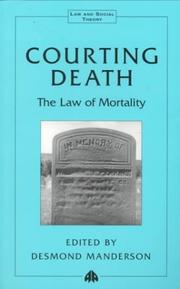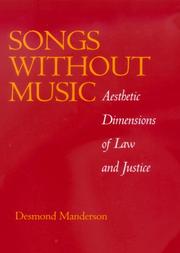| Listing 1 - 8 of 8 |
Sort by
|
Book
ISBN: 9781442630321 1442630329 9781442630338 1442630337 1442630310 9781442630314 Year: 2018 Publisher: Toronto : University of Toronto Press,
Abstract | Keywords | Export | Availability | Bookmark
 Loading...
Loading...Choose an application
- Reference Manager
- EndNote
- RefWorks (Direct export to RefWorks)
In Law and the Visual, leading legal theorists, art historians, and critics come together to present new work examining the intersection between legal and visual discourses.

ISBN: 0745313612 Volume: *5 Publisher: London : Pluto Press.
Abstract | Keywords | Export | Availability | Bookmark
 Loading...
Loading...Choose an application
- Reference Manager
- EndNote
- RefWorks (Direct export to RefWorks)
Mort --- Peine de mort --- Euthanasie --- Rites funeraires
Book
ISBN: 9781107158665 9781316665985 9781316611265 Year: 2019 Publisher: Cambridge Cambridge University Press
Abstract | Keywords | Export | Availability | Bookmark
 Loading...
Loading...Choose an application
- Reference Manager
- EndNote
- RefWorks (Direct export to RefWorks)
Law and art. --- Law in art. --- Time (Law) --- Time and art. --- Time in art. --- Social aspects. --- Law --- Art --- Chronology --- art [fine art] --- law [discipline] --- time --- art [discipline]

ISBN: 128275873X 9786612758737 0520922212 1597349062 9780520922211 0585389837 9780585389837 9780520216884 0520216881 9781597349062 0520216881 9781282758735 6612758732 Year: 2000 Publisher: Berkeley, Calif. : University of California Press,
Abstract | Keywords | Export | Availability | Bookmark
 Loading...
Loading...Choose an application
- Reference Manager
- EndNote
- RefWorks (Direct export to RefWorks)
In this pathbreaking and provocative analysis of the aesthetics of law, the historian, legal theorist, and musician Desmond Manderson argues that by treating a text, legal or otherwise, as if it were merely a sequence of logical propositions, readers miss its formal and symbolic meanings. Creatively using music as a model, he demonstrates that law is not a sterile, rational structure, but a cultural form to be valued and enhanced through rhetoric and metaphors, form, images, and symbols. To further develop this argument, the book is divided into chapters, each of which is based on a different musical form. Law, for Manderson, should strive for neither coherence nor integrity. Rather, it is imperfectly realized, constantly reinterpreted, and always in flux. Songs without Music is written in an original, engaging, and often humorous style, and exhibits a deep knowledge of both law and music. It successfully traverses several disciplines and builds an original and persuasive argument for a legal aesthetic. The book will appeal to a broad readership in law, political theory, literary criticism, and cultural studies.
Law and aesthetics. --- Aesthetics and law --- Aesthetics --- aesthetics. --- argument. --- argumentation. --- composition. --- creative nonfiction. --- cultural studies. --- form. --- justice. --- law. --- legal argument. --- legal brief. --- legal interpretation. --- legal precedence. --- legal text. --- legal writing. --- literary criticism. --- living constitution. --- living law. --- metaphor. --- music theory. --- music. --- musical forms. --- narrative structure. --- narrative theory. --- nonfiction. --- philosophy. --- political theory. --- rhetoric. --- symbolism. --- text. --- writing.
Book
ISBN: 1108698093 1316665984 1107158664 1108670458 1316611264 Year: 2019 Publisher: Cambridge : Cambridge University Press,
Abstract | Keywords | Export | Availability | Bookmark
 Loading...
Loading...Choose an application
- Reference Manager
- EndNote
- RefWorks (Direct export to RefWorks)
The visual arts offer refreshing and novel resources through which to understand the representation, power, ideology and critique of law. This vibrantly interdisciplinary book brings the burgeoning field to a new maturity through extended close readings of major works by artists from Pieter Bruegel and Gustav Klimt to Gordon Bennett and Rafael Cauduro. At each point, the author puts these works of art into a complex dance with legal and social history, and with recent developments in legal and art theory. Manderson uses the idea of time and temporality as a focal point through which to explore how the work of art engages with and constitutes law and human lives. In the symmetries and asymmetries caused by the vibrating harmonic resonances of these triple forces - time, law, art - lies a way of not only understanding the world, but also transforming it.
Law in art. --- Law and art. --- Time in art. --- Time and art. --- Time (Law) --- Civil procedure --- Notice (Law) --- Limitation of actions --- Art and time --- Art --- Art and law --- Social aspects. --- Collectors and collecting --- Law and legislation
Book
ISBN: 0203123638 0415529514 0415598273 1136340467 1136340475 128351995X 9786613832405 Year: 2012 Publisher: Hoboken Routledge
Abstract | Keywords | Export | Availability | Bookmark
 Loading...
Loading...Choose an application
- Reference Manager
- EndNote
- RefWorks (Direct export to RefWorks)
Book
ISBN: 9781442630314 Year: 2018 Publisher: Toronto Buffalo London University of Toronto Press
Abstract | Keywords | Export | Availability | Bookmark
 Loading...
Loading...Choose an application
- Reference Manager
- EndNote
- RefWorks (Direct export to RefWorks)
In Law and the Visual, leading legal theorists, art historians, and critics come together to present new work examining the intersection between legal and visual discourses. Proceeding chronologically, the volume offers leading analyses of the juncture between legal and visual culture as witnessed from the fifteenth to the twenty-first centuries. Editor Desmond Manderson provides a contextual introduction that draws out and articulates three central themes: visual representations of the law, visual technologies in the law, and aesthetic critiques of law. A ground breaking contribution to an increasingly vibrant field of inquiry, Law and the Visual will inform the debate on the relationship between legal and visual culture for years to come
Book
ISBN: 1399505106 9781399505109 9781399505086 1399505114 1399505084 Year: 2023 Publisher: Edinburgh: Edinburgh University Press,
Abstract | Keywords | Export | Availability | Bookmark
 Loading...
Loading...Choose an application
- Reference Manager
- EndNote
- RefWorks (Direct export to RefWorks)
What do Margaret Atwood or Gulliver’s Travels have to do with Facebook, Tik Tok or COVID-19 and issues of surveillance?Covers a range of topical issues ranging from the security state and the power of tech industries, to COVID-19 and the role of surveillance in the experience of indigenous peoples in post-colonial societiesCompares legal frameworks and offers an overview of surveillance in France, the UK, US, Canada and AustraliaDraws on a range of resources including literary texts, such as Jonathan Raban’s Surveillance, Margaret Atwood's Bodily Harm and The Testaments and Jonathan Swift’s Gulliver’s TravelsExamines the key concepts involved in surveillance studies, including surveillance itself, privacy, identity, trust, consent, agency and securityThe growing sophistication of surveillance practices has given rise to concerns and discussions in the public sphere, but has also provided a popular theme in literature, film and the arts. Bringing together contributors across literary studies, law, philosophy, sociology, and politics, this book examines the use, evolution, legitimacy, and implications of surveillance.Drawing on a range of resources including literary texts, chapters explore key issues such as the use and legitimacy of surveillance to address a global health crisis, the role of surveillance in the experience of indigenous peoples in post-colonial societies, how surveillance interacts with gender race, ethnicity, and social class, and the interaction between technology, surveillance, and changing attitudes to expression. It shows how literature contributes innovative ways of thinking about the challenges posed by surveillance, how philosophy and sociology can help to correct biases and law and politics can offer new approaches to the legitimacy, use and implications of surveillance.
Law and the humanities. --- Police patrol --- Surveillance operations --- Law and legislation. --- Police --- Humanities and law --- Humanities --- Electronic surveillance
| Listing 1 - 8 of 8 |
Sort by
|

 Search
Search Feedback
Feedback About UniCat
About UniCat  Help
Help News
News